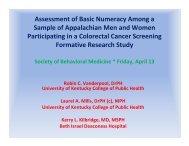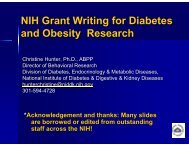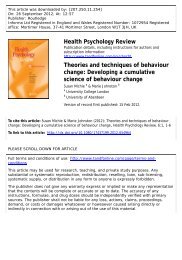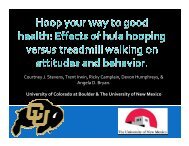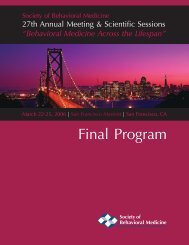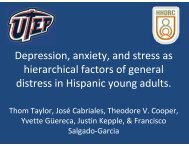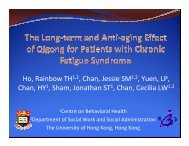Claudio R. Nigg, PhD - Society of Behavioral Medicine
Claudio R. Nigg, PhD - Society of Behavioral Medicine
Claudio R. Nigg, PhD - Society of Behavioral Medicine
You also want an ePaper? Increase the reach of your titles
YUMPU automatically turns print PDFs into web optimized ePapers that Google loves.
Interrelationships Across Three<br />
Health Behaviors:<br />
Theory and Research<br />
Sonia Lippke, <strong>PhD</strong> (Free University Berlin, Germany), &<br />
<strong>Claudio</strong> R. <strong>Nigg</strong>, <strong>PhD</strong> (University <strong>of</strong> Hawaii-Manoa, USA),<br />
Jason E. Maddock, <strong>PhD</strong> (University <strong>of</strong> Hawaii-Manoa, USA)<br />
Contact: cnigg@hawaii.edu<br />
Symposium: Developing Multiple Risk Factor Interventions<br />
<strong>Society</strong> <strong>of</strong> <strong>Behavioral</strong> <strong>Medicine</strong>, Seattle, April 9, 2010<br />
Support: Hawaii State Department <strong>of</strong> Health Tobacco Settlement Special Fund &<br />
a travel grant by the German Research Foundation<br />
(Deutsche Forschungsgemeinschaft, DFG).
Rationale<br />
Non-smoking, healthy nutrition and<br />
physical activity (PA) - core factors <strong>of</strong> a<br />
healthy lifestyle (Mokdad et al., 2004).<br />
Populations with multiple behavior risk<br />
factors:<br />
– ↑ chronic disease & premature death compared<br />
single or no behavioral risk factors, and<br />
– account for a disproportionate percentage <strong>of</strong><br />
health care costs
Rationale<br />
Multiple health behavior theory is<br />
developing (Noar et al., 2008)<br />
Inform interventions<br />
– may yield ↑ benefit for prevention,<br />
rehabilitation, disease management, and ↓<br />
health care costs<br />
Therefore, we need to know more about<br />
healthy lifestyle patterns and, in particular,<br />
about their mechanisms (Prochaska et al.,<br />
2008)
Transfer Theory<br />
Transfer - history in teaching and learning<br />
(Barnett & Ceci, 2002)<br />
Transferring depends on dimensions, e.g.,<br />
content and context (Barnett & Ceci, 2002)<br />
Some aspects same in different domains<br />
– intending, planning, and overcoming<br />
temptations<br />
Other aspects might be unique for each<br />
behavior<br />
– such as the concrete “how”
Transfer Theory - example
Compensation Theory<br />
Based on the ideas <strong>of</strong> the<br />
Compensatory Health Belief Model<br />
(Knauper et al 2004)<br />
People who perform a risk behavior<br />
may compensate by performing a<br />
health behavior
Compensation Theory -<br />
Example
Purpose<br />
To see if people transfer or<br />
compensate health behaviors<br />
– As evidenced by positive or negative<br />
correlations<br />
To investigate if smoking moderates<br />
transfer or compensation effects<br />
– As smoking has been identified as a<br />
gateway drug (Biederman et al., 2007;<br />
<strong>Nigg</strong> et al., 2009)
Participants<br />
N = 3,519; 60.3% female;<br />
– 34.2% White,<br />
– 19% Japanese,<br />
– 17.9% Native Hawaiian/Part Hawaiian,<br />
– 9.4% Filipinos, and<br />
– 19.4% “Other/Mixed Race.”<br />
Mean age = 46.31, SD = 16.31;<br />
4.7% < high school, 28% high school degree,<br />
27.5% some college, 39.4% graduated college;<br />
BMI = 25.68, SD = 5.27.<br />
– 2.9% underweight (BMI < 18);<br />
– 47.3% normal weight (BMI = 18-24);<br />
– 30.1% overweight (BMI = 25-30);<br />
– 16.3% obese (BMI = 30+).
Procedures<br />
Random digit dialing<br />
Trained interviewers, using CATI<br />
conducted a 20-minute survey<br />
Randomization within household - person<br />
>18 who had the last birthday<br />
UH IRB approved, phone consent<br />
Assessed stage <strong>of</strong> change<br />
– PA, fruit and vegetable consumption, and<br />
smoking
Stage Prevalence<br />
%<br />
60<br />
50<br />
40<br />
30<br />
20<br />
10<br />
0<br />
PC C PR A M<br />
Stage<br />
Note: 61/9% never smoked; percentages may not add<br />
to 100% due to missing data<br />
PA<br />
FV<br />
Smoking
Non-parametric correlations<br />
between behaviors<br />
0.2<br />
Correlations<br />
0.16<br />
0.12<br />
0.08<br />
0.04<br />
0<br />
PA-Nut PA-Tob Nut-Tob<br />
Behavior Pairs<br />
Note: all p’s
Non-parametric correlations: PA &<br />
nutrition by smoking stages and neversmokers<br />
0.4<br />
0.35<br />
p=.02<br />
Correlations<br />
0.3<br />
0.25<br />
0.2<br />
0.15<br />
0.1<br />
0.05<br />
p=.06<br />
p=.02<br />
ns<br />
p
Discussion –<br />
Support for Transfer<br />
PA, nutrition, and tobacco smoking<br />
are interrelated<br />
PA & nutrition ↑ correlated than<br />
smoking & nutrition or smoking &<br />
exercise<br />
– PA and nutrition are preventive<br />
behaviors and are adopted<br />
– Smoking is a risk behavior which needs<br />
to be reduced
Discussion – Support for<br />
Moderation <strong>of</strong> Transfer<br />
Ex-smokers - ↑ correlations <strong>of</strong> nutrition &<br />
PA than never-smokers<br />
– Transfer: Individuals who quit smoking are<br />
more likely to eat healthy if they also do PA<br />
Surprisingly, some current-smokers (e.g.<br />
contemplators) also ↑ interrelation <strong>of</strong><br />
nutrition & PA than never-smokers<br />
– Some current-smokers may have a history <strong>of</strong><br />
quit attempts
Limitations<br />
Cross-sectional - which behavior<br />
changed first?<br />
Conclusions<br />
– based on theoretical assumptions<br />
– based on stage comparisons, not stage<br />
transitions<br />
Prospective and experimental<br />
studies recommended
So…<br />
“Don’t drink, don’t smoke…”<br />
~Adam Ant



